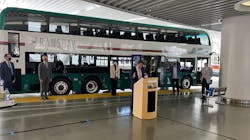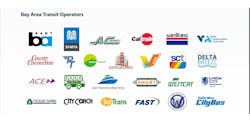Bay area transit agencies release joint plan to bolster trust in transit
Bay area transit agencies are joining forces to deliver what riders have asked for throughout the COVID-19 pandemic: assurance that a safe ride is being provided.
“It has never been more critical for our respective agencies to come together and collaborate with a common goal of preserving safe, reliable public transit for those who need it most,” said San Mateo County Transit District General Manager/CEO Jim Hartnett. “While COVID-19 presents much uncertainty, it remains a constant that the regional economy cannot sustainably rely solely on single-occupancy vehicles.”
The foundation of this joint effort by the mobility providers is the “Riding Together: Bay Area Healthy Transit Plan,” which is the result of the Blue Ribbon Transit Recovery Task Force formed by the Metropolitan Transportation Commission. The plan outlines what customers can expect from transportation providers, what these providers expect of riders and what employees can expect from their employers by way of safety precautions.
The group of agencies say this shared commitment to implement the industry’s best health-related practices is based on information from the California Department of Public Health, U.S. Centers for Disease Control and Prevention and the World Health Organization. The steps laid out in the plan apply to both directly operated services, as well as those that are contracted out.
“Economic recovery can't happen without transit. And transit doesn't work if our passengers and operators don't feel safe,” said San Francisco Municipal Transportation Agency (SFMTA) Director of Transportation Jeffrey Tumlin. “The SFMTA’s Transportation Recovery Plan uses the latest international data and best practices to support San Francisco’s economic recovery by providing more essential trips, protecting the health and safety of our employees and customers and serving those who are most dependent on transit.”
The plan outlines action items for frequent cleaning, personal protective equipment, face coverings, social distancing, ventilation and touchless fares.
Health and safety action items to protect riders include:
- Face coverings: Remind riders that masks are required, and transit providers have the right to refuse anyone without a face covering. Some transit operators will provide face coverings as capabilities allow.
- Physical distancing: Communicate importance of social distancing to riders and manage capacity to achieve the three-feet social distancing minimum requirement with face coverings.
- Hand hygiene: Provide information if hand-washing stations or hand sanitizer dispensers are available to customers.
- Quiet ride: Launch the “Quiet Ride” campaign to ask riders to minimize talking, singing or other verbal activities that might facilitate the spread of COVID-19.
- Cleaning and disinfecting: Clean and disinfect in-service vehicles daily with an emphasis on high touch areas. Use EPA- “List N” disinfectants with an elevated focus on vehicles that may have carried an infected rider.
- Ventilation: Maximize fresh air on vehicles and facilities based on ventilation options. Confirm maintenance on ventilation equipment and ensure systems offer peak performance.
- Touchless fares: Public outreach to encourage use of Clipper card for fare payments.
- Paratransit: A greater focus on cleaning and disinfecting surfaces in paratransit vehicles as riders with disabilities can have heightened vulnerabilities due to underlying health conditions, and more likely to be exempt from the face-covering requirement.
Keeping transit employees safe is critical for the successful operation of the Bay Area’s transportation network. The plan includes standards for agencies to protect their workers:
- Wellness Assessment: Develop and implement a COVID-19 assessment protocol for employees prior to accessing transit facilities or vehicles.
- PPE: Supply workers with Personal Protective Equipment including face masks (unless exempt). Perform job hazard analysis to identify potential exposure possibilities.
- Physical distancing: Determine common space capacities, stagger work hours, encourage eating outside and other social distancing tactics.
- Testing: Workers deemed essential have been given priority testing. Encourage workers to stay home if they feel sick.
- COVID-positive employees: Record which employees are in facilities at any time and notify workers if they have possibly been exposed to someone who tested positive for the virus.
“During these difficult times, our agencies have rolled up our sleeves and met extraordinary challenges with great creativity and dedication,” said Santa Clara Valley Transportation Authority General Manager/CEO and American Public Transportation Association Chair Nuria Fernandez. “We have doubled down on measures that protect the safety and health of transit employees and transit riders and are working extremely hard to show customers that we are safe, clean and consistent in our mission to provide mobility solutions for everyone.”
The full plan can be viewed here and the group of agencies will soon add a dashboard to report individual metrics.

Mischa Wanek-Libman | Group Editorial Director
Mischa Wanek-Libman is director of communications with Transdev North America. She has more than 20 years of experience working in the transportation industry covering construction projects, engineering challenges, transit and rail operations and best practices.
Wanek-Libman has held top editorial positions at freight rail and public transportation business-to-business publications including as editor-in-chief and editorial director of Mass Transit from 2018-2024. She has been recognized for editorial excellence through her individual work, as well as for collaborative content.
She is an active member of the American Public Transportation Association's Marketing and Communications Committee and served 14 years as a Board Observer on the National Railroad Construction and Maintenance Association (NRC) Board of Directors.
She is a graduate of Drake University in Des Moines, Iowa, where she earned a Bachelor of Arts degree in Journalism and Mass Communication.



